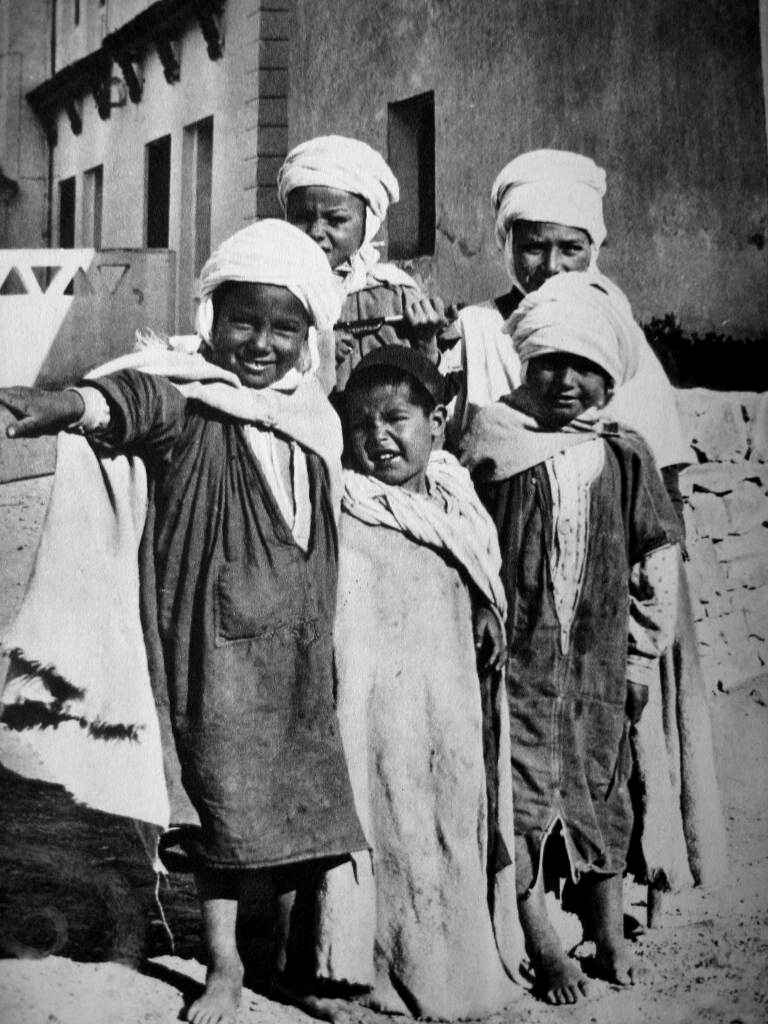
Algerian Boys' Clothes: Traditional Styles

Figure 1.--This photo was taken in Algeria during 1930s. The children wearing the traditional clothing. The fez the little boy is wearing, but the turbans the other boys are wearing looks are Arab or Bedouin in style and were probably worn for centuries. Notice that the children are living in a town so are not Befouin.
|
|
We do not yet have much historical clothing information on Algeria. What is now Algeria was part of the Roman Empire. Styles even at that time were not all Roman. Away from the coastal area, the Beouine popultion was not Romanized. Algeria was conquered by Arab invaders (8th century). Clothing styles appear to have become heavily influenced by Arab styles for the next 13 centuries. We do not yet know if there were destinctive Algerian styles. Our information in these historical periods is very limited. Unlike Europe, there are very few artistic images to draw on because of Islamic prohibition of personal representation. We note Algerian boys wearing fezes, baggy trousers, and other Arab traditional garments. Headwear actually seems varied. We note a range of scull caps as well as turban-like headwear. We are not sure to what extent the garments are Arab in origin or reflect influens of pre-Islsmic Bedouin tribes. The most common garment seems to be a calf-length robe-like garments. We believevit dates tonthe middle ages, but are not sure what the garment is called. Algerian has been a very poor country. Many Algerian boys went barefoot, especially boys living outside the major cities. This was common throughout the Arab Muslim world and was basically a reflection of poverty.
Historical Background
We do not yet have much historical clothing information on Algeria. What is now Algeria was part of the Roman Empire. Styles even at that time were not all Roman. Away from the coastal area, the Beouine popultion was not Romanized. Algeria was conquered by Arab invaders (8th century). Clothing styles appear to have become heavily influenced by Arab styles for the next 13 centuries. We do not yet know if there were destinctive Algerian styles. Our information in these historical periods is very limited. Unlike Europe, there are very few artistic images to draw on because of Islamic prohibition of personal representation. Arab/Beouine styles persisted even after French colonization began (1830). While French styles became dominant in the cities and larger towns, Arab/Bedouine styles persisted in the countryside.
We note Algerian boys wearing fezes, robe-like garments, baggy trousers, and other Arab traditional garments. As far as we can tell these are primarily generalized ArabBedouine styles. There probably were some localized Bedoune styles, but we do niot yet have enough information to report on tghis. Headwear actually seems varied. We note a range of scull caps as well as turban-like headwear such as we see here (figure 1). We are not sure to what extent the garments are Arab in origin or reflect influences of pre-Islamic Bedouin tribes. The most common garment seems to be a calf-length robe-like garments. We believe it dates to the middle ages, but are not sure what the garment is called. Algeria since the collapse of the Roman Empire has been a very poor country. Many Algerian boys went barefoot, especially boys living outside the major cities. This was common throughout the Arab Muslim world and was basically a reflection of poverty.
HBC

Navigate the Boys' Historical Clothing Web Site:
[Return to the Main Algerian garment page]
[Introduction]
[Activities]
[Biographies]
[Chronology]
[Cloth and textiles]
[Clothing styles]
[Countries]
[Topics]
[Bibliographies]
[Contributions]
[FAQs]
[Glossaries]
[Images]
[Links]
[Registration]
[Tools]
[Boys' Clothing Home]
Navigate the Boys' Historical Clothing national pages:
[Return to the Main Algerian page]
[Return to the Main countries page]
[Australia]
[Belgium]
[England]
[France]
[Germany]
[Ireland]
[Italy]
[Japan]
[Korea]
[Mexico]
[Scotland]
[United States]
Created: 8:25 AM 3/6/2011
Last updated: 4:39 PM 5/24/2018



